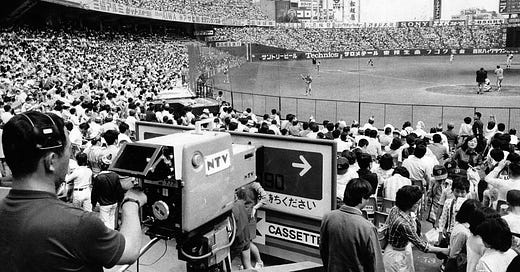Time Machine: Korakuen Stadium 1962
TOKYO — If baseball was the national religion of Japan and the Giants the national church, then Korakuen Stadium was its cathedral. There were two other ballparks in the city: Meiji Jingu Stadium in the Meiji Shrine complex, where Babe Ruth and visiting MLB all-stars had played in 1934, and Tokyo Stadium in out-of-the way Arakawa-ku, but Korakuen, built in 1937 and located in the middle of a downtown amusement park in the eastern part of the city, was the only one that actually looked like a major league stadium, with grass in the infield, unlike the other facilities used by Japanese professional baseball. Seating 45,000 it was a double decker park, 288 feet down the lines and 360 feet to center. Some said that it resembled Detroit's Briggs Stadium.
The stadium had been partially damaged by B-29 bombers during the war and used as an Occupation armaments dump until the GHQ deemed it desirable to have baseball played there again instead and promoted a tour of Japan by the 1949 San Francisco Seals. The two league system, Pacific and Central, started in 1950 and it was off to the races.
I would put on my fan uniform — Levi’s, polo shirt and baseball cap (Hanshin Tigers variety) — and buy a ticket for 150 yen to sit in the upper deck “jumbo stand” overlooking left field, with its panoramic views of the city. Korakuen had many charms— among them the roller coaster and the parachute drop visible next door, the various concession stands selling yakitori, yakisoba, sushi and hot dogs (made of fish meal) and the hot pants wearing young females who navigated the vertiginous upper deck stairways like mountain goats, dispensing Kirin draft beer from the enormous tanks strapped to their back while selling dried octopus to go along with it. There were punch-permed yakuza ticket scalpers patrolling the outer concourse if you wanted a more expensive seat in the infield area.
The jumbo stands were a great place to be on a summer night, looking out at the neon signs — a surrealistic mix of kana and kanji — and the Chuo train line in the distance. Chinese characters, some resembling giant insects or creatures from outer space, lined the outfield walls, advertising a myriad of products.: Suntory Jun nama Biru, National Color TV, Morinaga Chocolate, Sakura Color, Yokohama Tire, Fuji Color, Nihon Fire and Marine insurance, Toshiba Color telebi. Daiwa Shoken (in 1967). Many of them featured Giants stars Nagashima and Oh.
Keep reading with a 7-day free trial
Subscribe to Robert Whiting's Japan to keep reading this post and get 7 days of free access to the full post archives.




